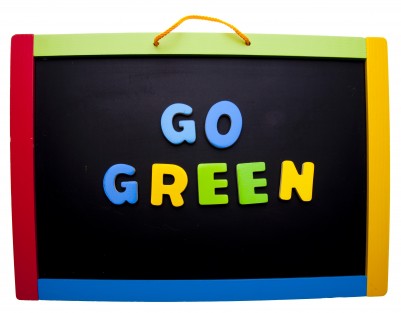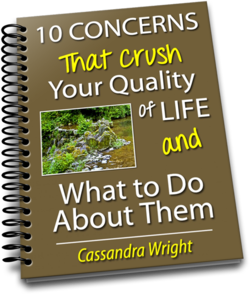Although we’re still enjoying bright summer days, the first day of school is drawing near. So, you’ve probably already begun back-to-school shopping or at least thinking about it.
It’s a given that as parents we want our kids to be healthy, happy and alert during class. Wouldn’t it be helpful to know that there are some specific actions we can take toward this goal when purchasing items for school? Would you like to go green with your back-to-school shopping?
Here are 3 of those actions:
1. Purchase Natural Fiber Clothing
Our first action while preparing for school is usually shopping for clothes. Unless your child’s school has a mandatory uniform as part of its dress code, you have a multitude of choices before you from low-rise to mid-rise jeans or slacks, short, 3/4 inch and long sleeves, a variety of dress styles, and so on.
But, I recommend that before you even think about the latest fashionable trend, decide that you are going to purchase natural fibered garments for your child.
Natural fibers include cotton, linen, wool, silk, ramie, and hemp. Try to avoid those that are treated to be wrinkle and/or stain resistant since many problematic chemicals are used to achieve this.
Advantages (depending on the manufacturing process) to using natural fibers instead of polyester, nylon, rayon, and other synthetics include:
Air Permeability:
Natural fibers allow air to flow through the garment which provides a balanced environment of air and moisture. This is great for your child’s skin.
Little to No Outgassing of Problematic Chemicals:
Natural fibers, if grown organically, will have no petrochemical outgassing while conventionally grown may have some but not as much as synthetics which are manufactured from the derivatives of petrochemicals.
Imagine breathing in these substances which can affect cognitive thinking while trying to concentrate during school.
Odor Release:
Natural fibers tend not to hold onto odors like their synthetic copies. Their permeability allows odors to be released more readily.
Biodegradability:
It can take a very long time, sometimes centuries, for a synthetic fiber to break down into it’s simplest form where as natural fibers have a much shorter period of decomposition.
Although these fabrics don’t offer the convenience of wash and wear that synthetics like polyester do, they don’t contribute to the potential of developing or worsening health conditions such as asthma and allergies either. They may require a little extra care but I don’t find that it adds a ton of work. It really only takes an extra 10 minutes to iron a few wrinkles out of a garment.
2. Purchase Eco-friendly School Supplies
Now our children are neatly dressed and ready to present themselves to the world of learning. We will continue with back-to-school shopping but will delve in to the bountiful world of school supplies.
Walk down the school supply isle of your local drug, office supply or Walmart stores and you will find a huge variety of items to choose from – pencils, pens, markers, unlined paper, lined paper, folders, files, spiral notebook, 3-ring binders, etc.
In addition to the many different types of supplies, they come in an assortment of colors, shades, patterns, and shapes. I actually find it fun sorting through them all and picking out just what my kids need.
However, as a health conscience parent I try to consider what affects these items will have on my child’s health. They may seem innocuous but some of the chemicals that they emit are anything but.
For instance, regular lined paper may be processed using chlorine or a derivative of it. Chlorine produces dioxins which are highly toxic and can irritate the respiratory system as well as other parts of the body.
Even though it seems to be just a small amount on one sheet of paper, we must remember that our children will encounter a large number of these sheets of paper throughout the school year. Enclose a couple of hundred sheets of lined paper into a vinyl (also a toxin) 3-ring binder and you have a toxic stack enveloped in a toxic shell.
Instead, we can opt for 100 percent recycled paper that is processed without chlorine and non-vinyl 3-ring binders. They cost a bit more but is your child’s health and wellbeing worth it?
Rather than ball point ink pens that are filled with ink derived from petrochemicals, you can opt to provide your student with water-based ink pens.
For art you have less toxic choices as well. For instance, instead of crayons made with petroleum derivatives try those made from soy or beeswax.There are some art supplies you can make yourself from all natural ingredients such as play dough and finger paint.
3. Personal Care Products
Whew! We’ve gathered clothes and school supplies. Our kids look good, are comfortable, and ready for the day’s wonderful learning experience.
But let’s back up a bit.
We’ve decided to provide them with healthier clothing options but what about the products that were used before they got dressed?
A variety of shampoos, conditioners, lotions, bubble bath, body washes, deodorants, and so on were used during the process of getting dressed.
If you read the labels, you will more than likely find a plethora of long-syllabled scientific words that designate the many chemicals that are used in these types of products. Some of them include quaternium-15 – a formaldehyde releaser, ethylene glycol, and other potentially harmful substances.
Try products containing more natural plant-based ingredients and less synthetic ones.


